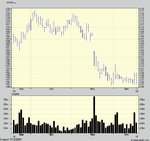What factors would you scan for a stock that is consolidating & awaiting a breakout?
Hi
What scans would you do to do a breakout play?
What factors would you use like Low volume - Small range in the past 5 days to scan for stocks that are consolidating after a recent upmove and may breakout soon? 🙂
Hi
What scans would you do to do a breakout play?
What factors would you use like Low volume - Small range in the past 5 days to scan for stocks that are consolidating after a recent upmove and may breakout soon? 🙂

